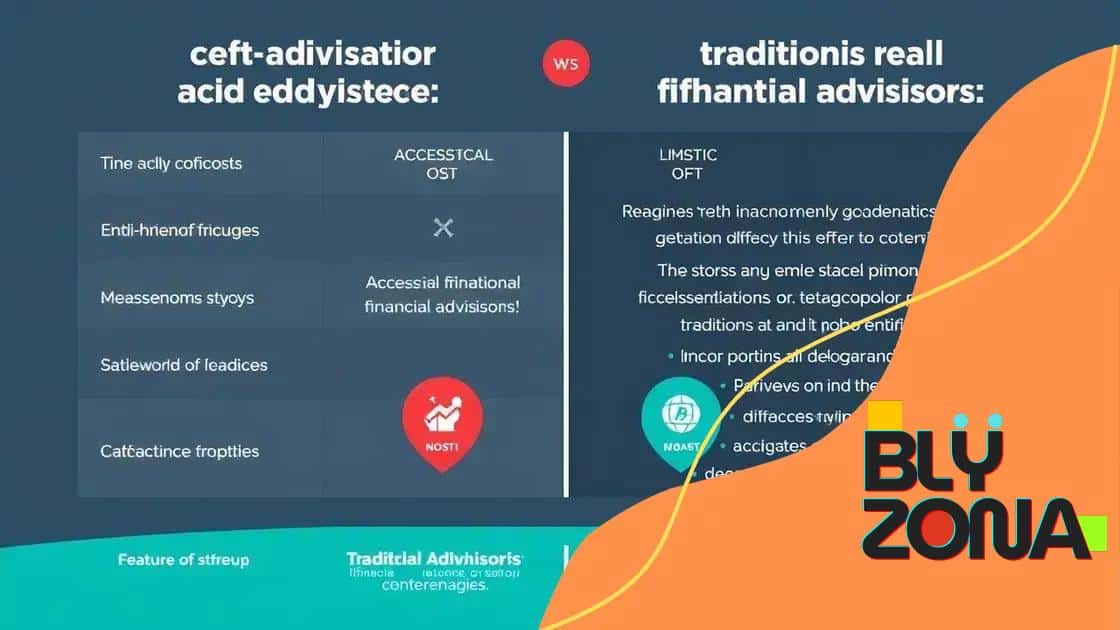Robo-advisors shaping the future of financial services

Robo-advisors are automated investment platforms that use algorithms to manage portfolios efficiently and cost-effectively, offering tailored financial solutions to investors of all experience levels.
Robo-advisors shaping the future of financial services is more than just a buzzword; it’s a game changer. Have you ever wondered how technology can simplify your investment journey? Let’s dive into this fascinating topic.
What are robo-advisors?
Robo-advisors are automated platforms that provide investment management services with minimal human intervention. They utilize algorithms to analyze your financial situation and investment goals. These platforms make investing simple, accessible, and cost-effective for everyone.
Understanding what robo-advisors are can help you make better financial decisions. They offer tailored portfolios based on your risk tolerance and investing preferences. This means you can start investing even if you don’t have extensive financial knowledge.
How Robo-Advisors Work
The technology behind robo-advisors is quite sophisticated. They gather data through questionnaires and then provide recommendations. Here are some key features of how they function:
- Automated portfolio management
- Low fees compared to traditional advisors
- Tax-loss harvesting
- Rebalancing portfolios automatically
This automation not only helps save time but also reduces costs. Many individuals find this approach more appealing due to its user-friendly nature. Clients are guided through each step, making investment choices easier.
Benefits of Robo-Advisors
Robo-advisors come with various benefits that make them attractive:
- Personalized investment plans
- Affordability and lower account minimums
- Easy tracking of investment progress
These advantages show how robo-advisors democratize access to investment opportunities.
In conclusion, robo-advisors represent a shift in the financial landscape, making investment approachable for everyone. They blend technology with financial planning, ensuring you have the tools necessary for effective investing.
The benefits of using robo-advisors
Using robo-advisors offers numerous advantages for modern investors looking for convenience and efficiency. These platforms simplify investing by automating key aspects of portfolio management. By leveraging technology, they can provide tailored investment strategies that align with your financial goals.
The cost-effectiveness of robo-advisors is another significant benefit. Traditional financial advisors often charge high fees, which can eat into your investment returns. In contrast, robo-advisors typically have lower fees, making investment accessible to more people.
Key Benefits of Robo-Advisors
Here are some principal benefits:
- Personalized Investment Plans: Robo-advisors assess your risk tolerance and financial goals to create a customized investment strategy.
- Automatic Portfolio Rebalancing: They regularly adjust your portfolio to maintain your desired risk level without requiring you to intervene.
- Lower Minimum Investments: Many robo-advisors allow you to start investing with little money, breaking down barriers to entry.
- Tax Optimization: Robo-advisors often utilize strategies like tax-loss harvesting to minimize your tax burden.
By utilizing robo-advisors, you can take advantage of these features without needing extensive investing knowledge. They provide a hands-off approach that frees up your time while still growing your wealth.
Additionally, the flexibility offered by these platforms means you can adjust your investment strategies easily. Whether you want to save for retirement, a home, or education, robo-advisors can help you reach your goals efficiently.
How robo-advisors compare to traditional advisors

Understanding how robo-advisors compare to traditional financial advisors is crucial for making informed investment decisions. Each option offers unique benefits that cater to different investor needs. Robo-advisors utilize technology to streamline the investment process, whereas traditional advisors provide personalized, face-to-face service.
One significant difference is the cost. Robo-advisors generally charge lower fees compared to traditional advisors, making them a more affordable choice. This cost advantage allows you to keep more of your investment returns over time. Furthermore, many robo-advisors have low or no minimum investment requirements, which is not commonly found with traditional advisors.
Key Differences
Here are some key differences between the two options:
- Personalization: Traditional advisors typically offer tailored advice based on individual client interactions. Robo-advisors, however, use algorithms to create investment strategies based on your provided information.
- Access to Advice: Robo-advisors are accessible 24/7 through digital platforms, while traditional advisors may have limited availability and require appointments.
- Investment Approaches: Traditional advisors often employ active management strategies, while robo-advisors mainly use passive investment strategies.
- Technology Use: Robo-advisors leverage advanced technology to automate tasks, reducing human error and improving efficiency.
The choice between a robo-advisor and a traditional advisor largely depends on your individual preferences and financial goals. If you value personalized attention and complex financial planning, you might lean toward a traditional advisor. On the other hand, if you prefer a cost-effective and straightforward approach, a robo-advisor could be your best option.
In today’s financial landscape, many investors are choosing a hybrid approach, utilizing both types of services. This flexibility allows them to benefit from the strengths of each method while addressing their unique financial needs.
Investment strategies powered by robo-advisors
Investment strategies powered by robo-advisors are designed to simplify and enhance the investing experience. By utilizing sophisticated algorithms, these platforms create tailored portfolios that align with your financial goals and risk tolerance. This automated approach ensures that your investments are managed efficiently while minimizing human error.
Typically, robo-advisors use a combination of asset allocation strategies based on modern portfolio theory. This means they diversify your investments across various asset classes to reduce risk and maximize returns. By balancing stocks, bonds, and other assets, they work to create a stable investment journey.
Types of Investment Strategies
Here are some common investment strategies employed by robo-advisors:
- Passive Investing: Many robo-advisors focus on low-cost index funds that aim to replicate market performance rather than outperform it.
- Risk-Based Allocation: They assess your risk tolerance through questionnaires to recommend an appropriate mix of investments.
- Tax-Loss Harvesting: Some platforms automatically sell investments at a loss to offset taxes on gains, optimizing your tax situation.
- Rebalancing: Robo-advisors automatically adjust your portfolio periodically to maintain your desired allocation across different asset classes.
This automated and systematic approach helps you stay invested for the long term while adapting to market changes. By leveraging robust data analytics, robo-advisors continuously refine their investment strategies to enhance performance.
Furthermore, many robo-advisors provide insights into the performance of your investments, helping you understand how your portfolio is performing over time. This transparency makes it easier for investors to stay informed and engaged with their financial goals.
Future trends in robo-advisory services
The future of robo-advisory services is bright and full of exciting possibilities. As technology continues to evolve, these platforms are likely to adopt more sophisticated algorithms and features that enhance user experience. Investors can expect increased personalization, making it easier to achieve their financial goals.
One trend we foresee is the growing use of artificial intelligence in robo-advisors. AI will analyze market trends and consumer behavior more accurately, allowing for smarter investment strategies. This can lead to better portfolio recommendations tailored to individual needs.
Enhanced User Experience
With the advancement of technology, robo-advisors will become even more user-friendly. This includes:
- Improved Mobile Interfaces: As more people invest using smartphones, we can expect enhanced mobile platforms that provide seamless experiences.
- Integration with Other Financial Tools: Future robo-advisors may connect with budgeting apps or spending trackers, offering a holistic view of one’s finances.
- Voice Activation: Incorporating voice commands could make interactions easier, allowing users to manage investments hands-free.
Moreover, sustainability is becoming more important to investors. Many robo-advisors are beginning to include socially responsible investing options in their portfolios. This means that users can invest in companies that align with their values, supporting environmental and social causes.
Additionally, as regulations around financial services evolve, robo-advisors will need to adapt to ensure compliance while continuing to provide value. This includes maintaining user privacy and transparency about investment strategies.
robo-advisors are transforming the investment landscape. They offer affordable, accessible, and efficient ways for people to manage their finances. As technology advances, we can expect robo-advisors to become even more sophisticated and user-friendly. They will continue to provide valuable services, like personalized investing and sustainable options, making it easier for everyone to achieve their financial dreams. With these innovations, robo-advisors will likely play a key role in shaping the future of finance, helping investors navigate their paths confidently and effectively.
FAQ – Frequently Asked Questions about Robo-Advisors
What is a robo-advisor?
A robo-advisor is an automated platform that provides investment management services using algorithms to create and manage portfolios based on individual goals.
How do robo-advisors differ from traditional financial advisors?
Robo-advisors usually have lower fees and operate online, while traditional advisors offer personalized services and face-to-face interactions.
What are the benefits of using a robo-advisor?
Benefits include cost-effectiveness, automated portfolio rebalancing, personalized investment plans, and access to sustainable investment options.
Are robo-advisors suitable for beginners?
Yes, robo-advisors are great for beginners since they provide user-friendly platforms that guide users through the investing process without requiring extensive financial knowledge.





